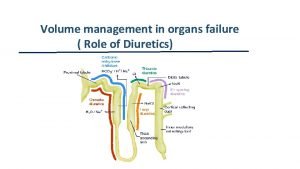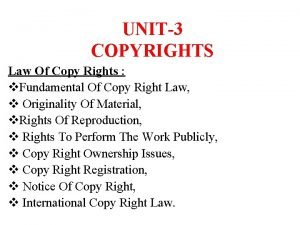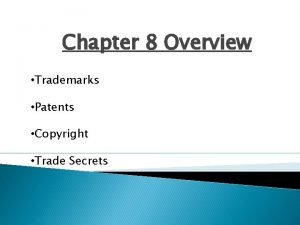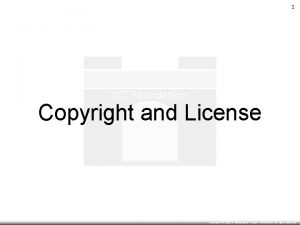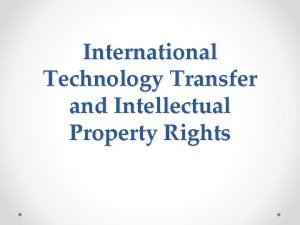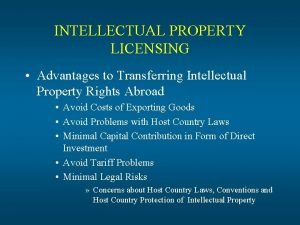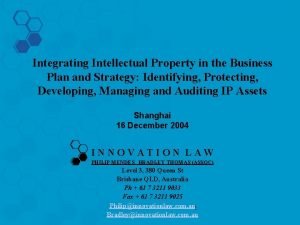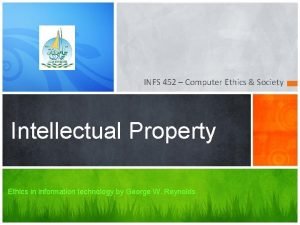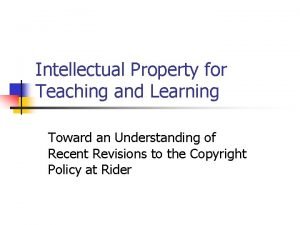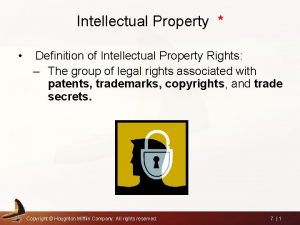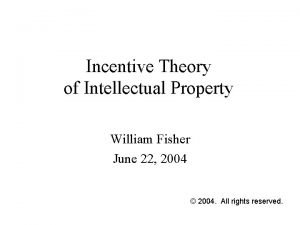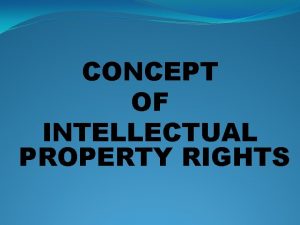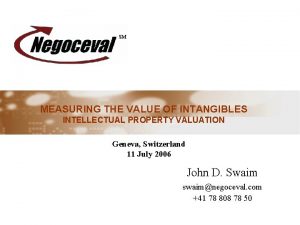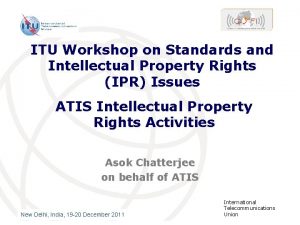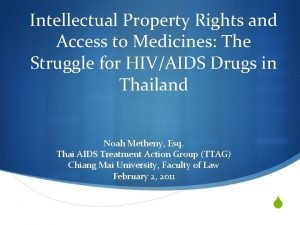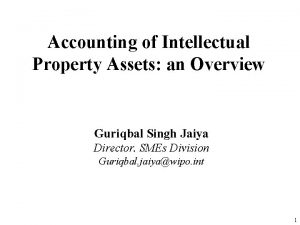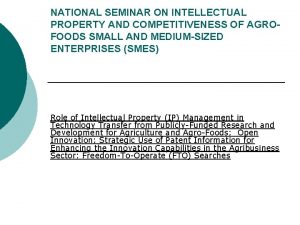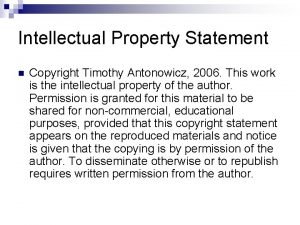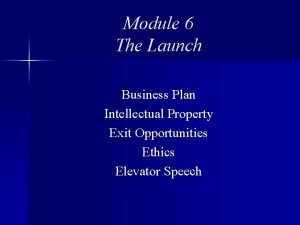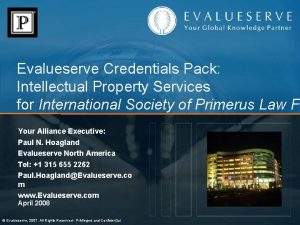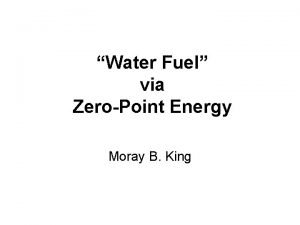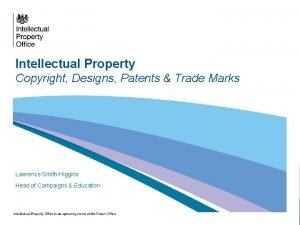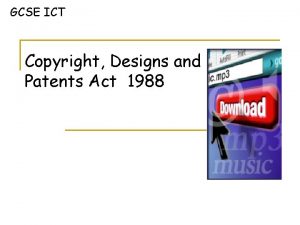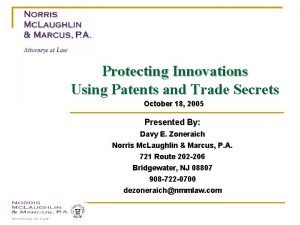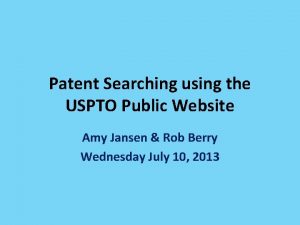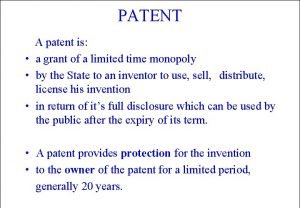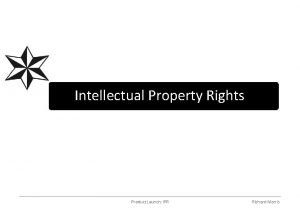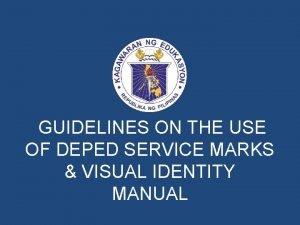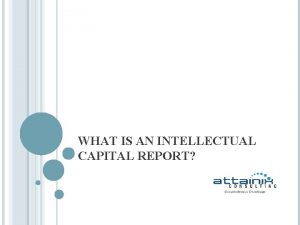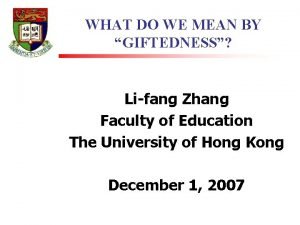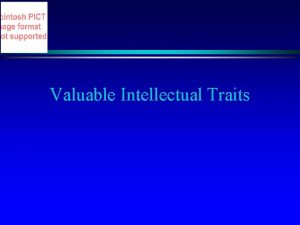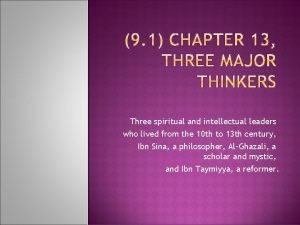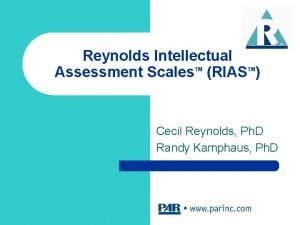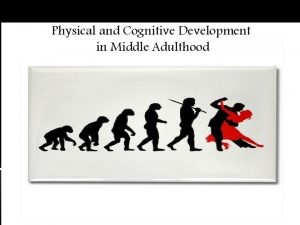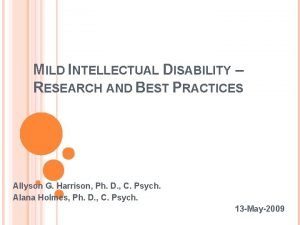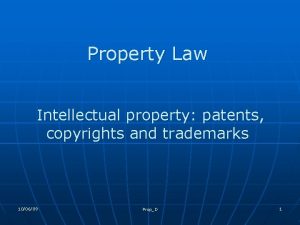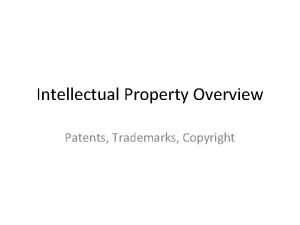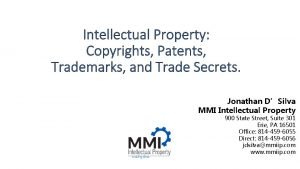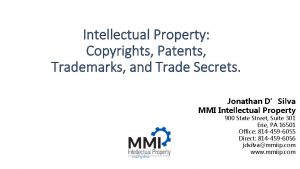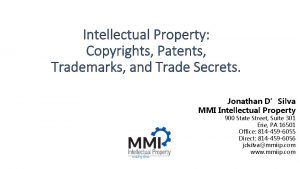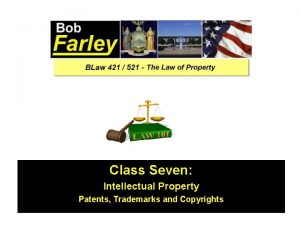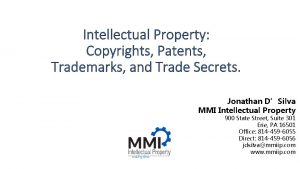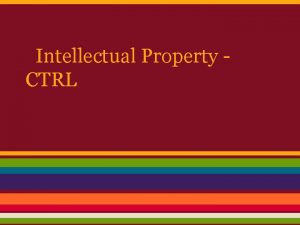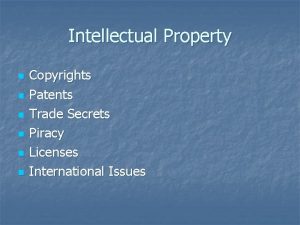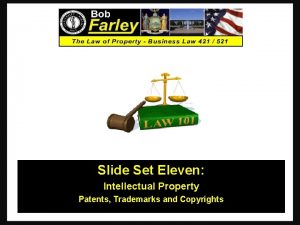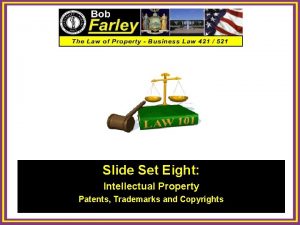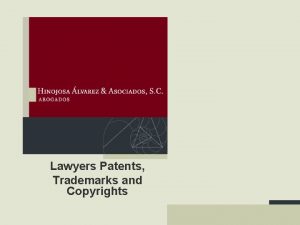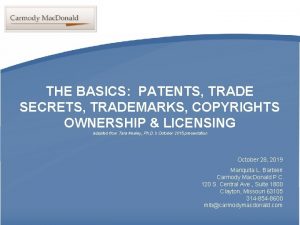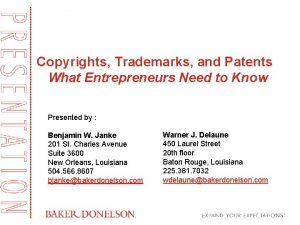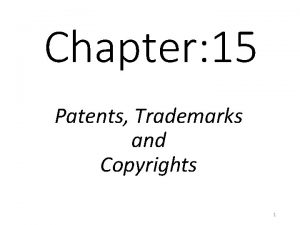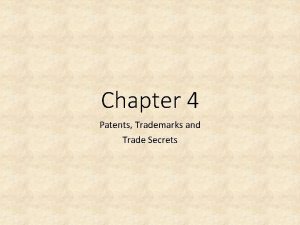Intellectual Property Trademarks or Service Marks Copyrights Patents


















































- Slides: 50

Intellectual Property • • Trademarks or Service Marks Copyrights Patents Trade Secrets (c) 2004 West Legal Studies in Business A Division of Thomson 1

What is a trademark? • Lanham Act 1976 – A word, symbol, or phrase, used to identify a particular manufacturer or seller’s products and distinguish them from the products of another. – Must be used or promise a “good faith” intent to be used, in interstate commerce • Nike and the “swoosh” • Coca-Cola (c) 2004 West Legal Studies in Business A Division of Thomson 2

Registration with the U. S. Patent & Trademark Office (USPTO) • Gives the trademark owner the right to sue for infringement and dilution – Same word can be used as a trademark for different classes of products – Word can only be used as a domain name by one product (c) 2004 West Legal Studies in Business A Division of Thomson 3

What Prerequisites Necessary for a Trademark? • Must be distinctive – capable for identifying the source of a particular good. • USPTO’s five categories of words: – Generic – Descriptive – Arbitrary or Fanciful – Suggestive – Fanciful (c) 2004 West Legal Studies in Business A Division of Thomson 4

Generic – Describes the general category to which the underlying product belongs: computer, apples, bread – Gets no protection – A trademark can become generic • coke, kleenex, xerox, etc. (c) 2004 West Legal Studies in Business A Division of Thomson 5

Arbitrary or Fanciful • No logical relationship to the product : Exxon, Kodak, Amazon (c) 2004 West Legal Studies in Business A Division of Thomson 6

Suggestive • Evokes or suggests a characteristic of the underlying good: “Coppertone” (c) 2004 West Legal Studies in Business A Division of Thomson 7

Descriptive • Directly describes, rather than suggests, a characteristic or quality of the underlying product: Holiday Inn, All Bran, Vision Center • Cannot be registered - Not inherently distinctive until it has acquired a “secondary meaning” (c) 2004 West Legal Studies in Business A Division of Thomson 8

Service Mark • Words, phrases, logos, or other graphic symbols that identify and distinguish the services of a company – Put “sm” next to the mark – Example Jiffy Lube (c) 2004 West Legal Studies in Business A Division of Thomson 9

Trade Dress • Protection can extend beyond the words, symbols and phrases to other aspects of the product, such as its color or design or shape or of its packaging – Mc. Donald’s (c) 2004 West Legal Studies in Business A Division of Thomson 10

Web Page Design as Trade Dress – Two Pesos, Inc. v. Taco Cabana, Inc. • Court: Do not need secondary meaning – Wal-Mart Stores, Inc. v. Samara Brothers, Inc. • Court: Do need secondary meaning of design of children’s clothes to be established – distinguished Two Pesos because that trade dress was packaging – Harder now to get web page design protected as trade dress (c) 2004 West Legal Studies in Business A Division of Thomson 11

Registering the Mark with the USPTO • Must be capable of distinguishing the applicant’s goods, and/or services from those of others. • Must be using or have a good faith intent to use the mark (c) 2004 West Legal Studies in Business A Division of Thomson 12

Registration • Gives the party the right to use the mark nationwide, even if actual sales are limited to only a limited area. – Cannot, even with registration, make someone who was already using it in a given geographic area without registration stop using it in that area • Registration constitutes nationwide constructive notice to others that the trademark is owned by the party • Party can bring an infringement suit in federal court • Allows recovery of attorneys’ fees, and the potential for recovery of treble damages • Registration, after five years, becomes incontestable, and use of it is conclusively established – Circled R denotes actual notice of ownership (c) 2004 West Legal Studies in Business A Division of Thomson 13

Duration of a Mark • Lose trademark if: – Abandonment • No renewal of registration in the fifth year, expires at the end of the sixth year – Improper licensing or assignment – Genericity – becomes generic • Kleenex, xerox (c) 2004 West Legal Studies in Business A Division of Thomson 14

Secondary Meaning: • A descriptive mark can become distinctive – when the consuming public primarily associates that mark with a particular producer, rather than the underlying product – Holiday Inn has acquired this secondary meaning; public thinks of a particular chain of motels, not just any motel where people stay on holidays (c) 2004 West Legal Studies in Business A Division of Thomson 15

How to Establish Secondary Meaning • Descriptive marks cannot be registered until they acquire a secondary meaning • Courts’ test for secondary meaning: • The amount and manner of advertising under the term • The volume of sales under the term • The length and manner of the term’s use • Results of consumer surveys in recognition of a particular product, dress, or service (c) 2004 West Legal Studies in Business A Division of Thomson 16

Supplemental Register • May be registered on the Supplemental register – if it remains on this register for 5 years with continuous use in commerce, it is presumed that it has acquired secondary meaning. (c) 2004 West Legal Studies in Business A Division of Thomson 17

Establishing Secondary Meaning of Web pages • Register on the Supplemental register • Put ® to give actual notice of ownership • Register it as a domain name – NSI, now ICANN (c) 2004 West Legal Studies in Business A Division of Thomson 18

Domain Names • Created to serve a useful mnemonic means of locating specific computers on the Internet • Domain names are now highly visible in “real space” • Domain names can only link to one site, while trademarks can be used by two non-competing products • Many internet users “guess” at domain names (c) 2004 West Legal Studies in Business A Division of Thomson 19

Domain Name System • Until 1998 domain name system – was administered by the U. S. government (ICC) via contracts with the Internet Assigned Names and Numbers (IANA) and Network Solution, Inc. (NSI) • IANA: – administered the Internet address system through Jon Postel, who had volunteered to keep a master list of machine numbers and their correlating mnemonic names over 30 years ago. • NSI – registered domain names for the top level domains of. com. org. net. – new ones: . biz, . info, . museum, . areo, . coop, . name, . pro, (c) 2004 West Legal Studies in Business A Division of Thomson 20

U. S. decided to turn the DNS over to private management • 1999 U. S. government – turned system over to Internet Corporation for Assigned Names and Numbers (ICANN) • Supposed to open up domain-name registration to competition • can now register through a variety of registrars. (Veri. Sign) – Registrars located in many countries – ICANN maintains authority over them – Created UDRP (c) 2004 West Legal Studies in Business A Division of Thomson 21

Cannot Sue Registrars for Trademark Infringement • These registrar’s cannot be sued for giving Person B a domain name that contains Person A’s trademark – Lockheed Martin Corp. v. Network Solutions, Inc. – Motion Picture Arts and Sciences v. Network Solutions, Inc. (c) 2004 West Legal Studies in Business A Division of Thomson 22

ICANN Domain Name Dispute Resolution • Can settle disputes involving domain name holders being sued by trademark name holders – Administrative Panel Decision Julia Fiona Roberts v. Russell Boyd 2000 (c) 2004 West Legal Studies in Business A Division of Thomson 23

Trademark Infringement • Plaintiff must have prior rights in the trademark- easily proved by registration • The infringer must have used the trademark in connection with the sale of a good • There must be a “likelihood of confusion” for the consumer as to the source of those goods or as to the sponsorship or approval of such goods (c) 2004 West Legal Studies in Business A Division of Thomson 24

“Likelihood of Confusion” Factors Used by Courts: • • • Strength of the mark Proximity of the goods Similarity of the marks Similarity of marketing channels Degree of caution exercised by the typical purchaser Defendant’s intent Evidence of actual confusion Zone of natural expansion by plaintiff Length of time defendant used the mark Same sales efforts (c) 2004 West Legal Studies in Business A Division of Thomson 25

Infringement Examples • Check Point Systems, Inc. v. Check Point Software Technologies, Inc. • Apple computer and Apple records can coexist – no confusion to consumer • Applet computer would be an infringement (c) 2004 West Legal Studies in Business A Division of Thomson 26

Trademark Dilution • Federal Trademark Dilution Act 1996 – Only if the mark is registered – Only if the mark is famous and distinctive – Defendant’s use is causing dilution (c) 2004 West Legal Studies in Business A Division of Thomson 27

Dilution Can be Blurring or Tarnishment • Lessening of the capacity of a famous mark to identify and distinguish goods or services • Regardless of confusion by the consumer • Regardless of whether goods are competing (c) 2004 West Legal Studies in Business A Division of Thomson 28

Test for Whether Plaintiff’s Mark is Famous • • Degree of inherent or acquired distinctiveness Duration and extent of use Amount of advertising and publicity Geographic extent of the market Channels of trade Degree of recognition in trading areas Any use of similar marks by third parties Whether the mark is registered (c) 2004 West Legal Studies in Business A Division of Thomson 29

Trademark Dilution - Blurring or Tarnishment • Likelihood of confusion not necessary • Blurring: power of the mark is weakened through its identification with dissimilar goods – A. B. C. Carpet Co. , Inc. , et al. v. Naeini • Tarnishment: mark is cast in an unflattering light, typically through its association with inferior or unseemly products or services – Toys R Us v. Akkaoui (Adults “R” Us ) – Toys “R” Us. , et al. v. Richard Feinburg (gunsareus. com) (c) 2004 West Legal Studies in Business A Division of Thomson 30

Defenses? • Fair Use • Parody (c) 2004 West Legal Studies in Business A Division of Thomson 31

Fair use • Descriptive mark is used for its primary, rather than secondary meaning: like describing your cereal as “all bran” or your batter coating as “fish fry” • Nominative use: Using the words “just to talk about the object” (c) 2004 West Legal Studies in Business A Division of Thomson 32

Parody • Not too directly tied to commercial use • Artistic and editorial parodies of trademarks serve a valuable critical function – entitled to First Amendment protection (c) 2004 West Legal Studies in Business A Division of Thomson 33

Remedies • Infringement: – Defendant’s profits – Damages sustained by plaintiff • (may be trebled upon showing of bad faith) – Costs of the action • Dilution – Damages only if bad faith – Only injunctive relief (c) 2004 West Legal Studies in Business A Division of Thomson 34

A New Remedy - Anticybersquatting Consumer Protection Act (ACPA) • 1999 Protect trademark owners from cyber piracy • “A person shall be liable in a civil action by the owner of a mark, including a personal name which is protected as a mark, … if that person had a bad faith intent to profit from the mark” • Also illegal to register the domain name of a living person without his consent • Statutory damages or actual damages (c) 2004 West Legal Studies in Business A Division of Thomson 35

Indications of Bad Faith Under the ACPA • A federally registered trademark will be diminished • Domain-name owners intend to cause diversion of consumers or or dilution of the trademark • Domain-name owners offer to sell the name to the trademark owners • Domain-name owners applied for it by providing false information • Domain-name owners applied for multiple domain names registration (c) 2004 West Legal Studies in Business A Division of Thomson 36

Remedies under the ACPA • Sue for actual damages • Sue for statutory damages • Sue for transfer of name to plaintiff (c) 2004 West Legal Studies in Business A Division of Thomson 37

ACPA Case • E& J Gallo Winery v. Spider Webs Ltd. (c) 2004 West Legal Studies in Business A Division of Thomson 38

Trademark Owners Sued Infringing Domain Name Holders 1994 – Can sue for infringement, dilution, unfair trade practices, under the Anti. Cybersquatting Protection Act – Use ICANN’s Uniform Dispute Resolution Procedure (UDRP) – Use various dispute resolution bodies around the world • WIPO Arbitration and Mediation Center: Julia Roberts (c) 2004 West Legal Studies in Business A Division of Thomson 39

Domain Name Cases: • Sue for Internet Trademark Infringement – Deep linking • Ticketmaster v. Microsoft – Metatags • Playboy Enterprises Inc. v. Welles 2002 – Framing • Washington Post v. Total News, Inc. (c) 2004 West Legal Studies in Business A Division of Thomson 40

International Protection - Treaties • Agreement on Trade-Related Aspects of Intellectual Property Rights (TRIPS) • WTO treaty • Comprehensive set of rights and obligations governing international trade in intellectual property • Each member country must have a common minimum of protection for intellectual property rights within its own borders • Must observe the substantive provisions of certain treaties (c) 2004 West Legal Studies in Business A Division of Thomson 41

Treaties That Must be Observed By TRIPS Members – International Convention for the Protection of Industrial Property (Paris Convention) – Berne Convention for the Protection of Literary and Artistic Works (Berne Convention) – International Convention for the Protection of Performers, Producers of Phonograms, and Broadcasting Organizations (Rome convention) – Treaty on Intellectual Property in Respect of Integrated Circuits (IPIC Treaty) – Supplements to these treaties set by TRIPS • Copyrights at 50 years, patents at 20, trademarks at 7 (c) 2004 West Legal Studies in Business A Division of Thomson 42

TRIPS Sets Effective Enforcement Criteria • All must abide by WTO’s Dispute Resolution Understanding Agreement (c) 2004 West Legal Studies in Business A Division of Thomson 43

TRIPS Also Requires • Extension of the General Agreement on Tariffs and Trade (GATT) to international intellectual property rights • National Treatment Principle • Transparency Principle • Most–Favored Nation Treatment Principle • Least developed countries have until 2006 to reach standards (c) 2004 West Legal Studies in Business A Division of Thomson 44

Paris Convention • International Convention for the Protection of Industrial Property • Union of countries responsible for protecting industrial property rights: patents, trademarks and industrial designs • Must comply with 3 principles – National treatment principle – Right of Priority: 12 months retroactive time to file in other countries – Common rules establish basic minimum criteria and procedures for granting industrial property rights (c) 2004 West Legal Studies in Business A Division of Thomson 45

The Trademark Law Treaty 1994 • 35 countries • Harmonizes the following rules • Initial and renewal terms of registering trademarks is ten years • Service marks now have equal protection as trademarks • Various procedures related to renewal application, powers of attorney, authentication, streamlined (c) 2004 West Legal Studies in Business A Division of Thomson 46

Madrid Protocol • Single international trademark application and registration system • Managed by WIPO • Registration here is recognized as registration in any of the member countries (c) 2004 West Legal Studies in Business A Division of Thomson 47

International Trademark Disputes of Internet Domain Names • No one treaty • Individual country efforts – United Kingdom – France – Asia (c) 2004 West Legal Studies in Business A Division of Thomson 48

The Problem of Enforcement • Hard to find cybersquatters • Hard to enforce • Violator could transfer name to a third party (c) 2004 West Legal Studies in Business A Division of Thomson 49

WIPO Uniform Dispute Resolution Policy • Requires a showing of bad faith • Trademark Infringement does not require bad faith (c) 2004 West Legal Studies in Business A Division of Thomson 50
 Copyrights
Copyrights Copyrights
Copyrights First sale doctrine copyright
First sale doctrine copyright Copyrights
Copyrights Copyrights
Copyrights When to use exclamation mark
When to use exclamation mark Trade related aspects of intellectual property rights
Trade related aspects of intellectual property rights Intellectual property in professional practices
Intellectual property in professional practices Importance of intellectual property
Importance of intellectual property Intellectual property management definition
Intellectual property management definition Advantages of intellectual property
Advantages of intellectual property Intellectual property business plan example
Intellectual property business plan example Property
Property Right to intellectual property of teachers
Right to intellectual property of teachers Industrial property definition
Industrial property definition Theories of intellectual property william fisher
Theories of intellectual property william fisher Concept of intellectual property
Concept of intellectual property Valuation of ip
Valuation of ip Intellectual property rights
Intellectual property rights Intellectual property rights
Intellectual property rights Characteristics of intellectual property
Characteristics of intellectual property Discuss intellectual property frankly
Discuss intellectual property frankly Gaap accounting for intellectual property
Gaap accounting for intellectual property Intellectual property
Intellectual property Intellectual property statement
Intellectual property statement Intellectual property business plan example
Intellectual property business plan example Evalueserve ip
Evalueserve ip Discuss intellectual property frankly
Discuss intellectual property frankly At&t intellectual property
At&t intellectual property Tapping the zero point energy by moray b king
Tapping the zero point energy by moray b king Simproved harry potter world
Simproved harry potter world What is the copyright designs and patents act 1988
What is the copyright designs and patents act 1988 Copyright in ict
Copyright in ict Definition of trade secrets
Definition of trade secrets Advantages and disadvantages of patents
Advantages and disadvantages of patents Uspto
Uspto Insecticide act
Insecticide act Patents
Patents Do 31 s 2019
Do 31 s 2019 Commutative and associative properties
Commutative and associative properties Obstructed heritage in hindu law
Obstructed heritage in hindu law Chemical property of water
Chemical property of water Intellectual capital examples
Intellectual capital examples Lifang zhang
Lifang zhang Which intellectual trait includes conscious understanding
Which intellectual trait includes conscious understanding The intellectual and spiritual leaders
The intellectual and spiritual leaders Reynolds intellectual assessment scales sample questions
Reynolds intellectual assessment scales sample questions Intellectual development in middle adulthood
Intellectual development in middle adulthood Accommodations for borderline intellectual functioning
Accommodations for borderline intellectual functioning Ascending levels of intellectual demand
Ascending levels of intellectual demand Late adulthood mental development
Late adulthood mental development

